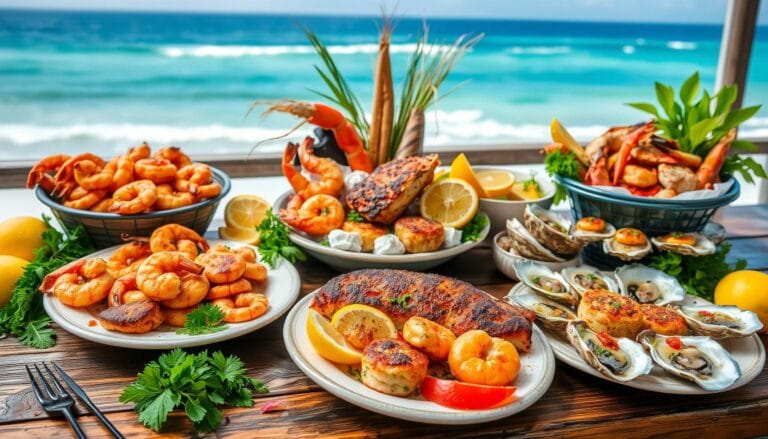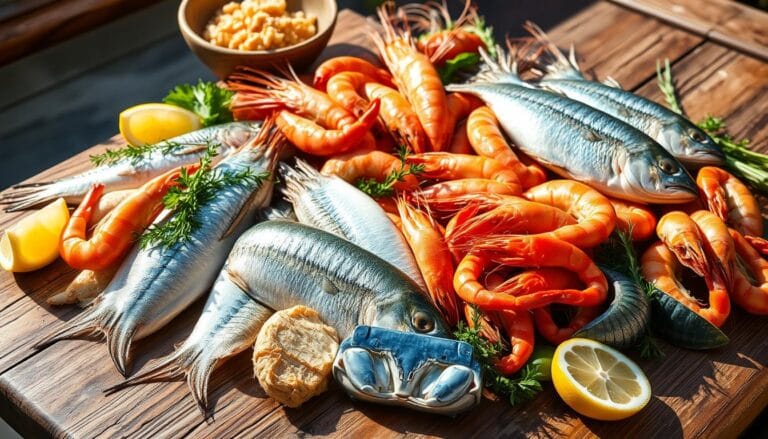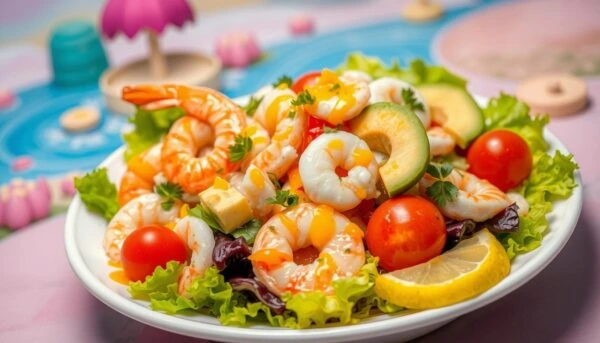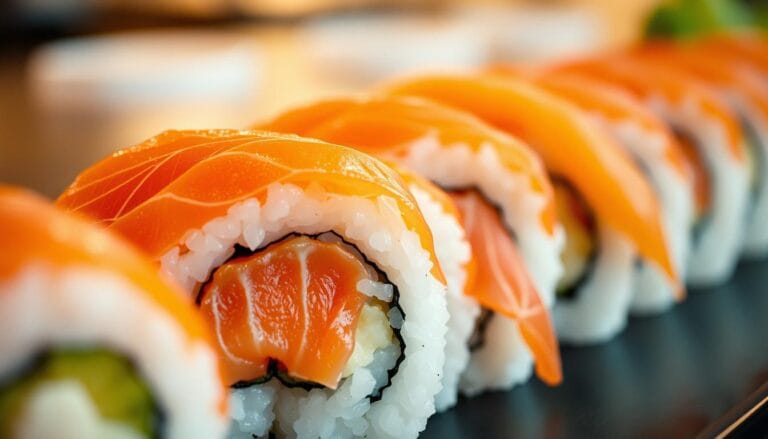Baked Teriyaki Salmon: 5 Tips for Flavorful, Easy Cooking
The smell of teriyaki salmon reminds me of my grandmother’s kitchen. It was a place where love and tradition came together in cooking. I saw her turn simple ingredients into amazing meals that united our family at dinner.
Baked teriyaki salmon is more than a recipe; it’s a journey of flavors. It’s perfect for anyone, whether you’re busy or just want a quick, tasty meal. You can make it in just 40 minutes.
Imagine making a salmon dish that tastes like it’s from a restaurant. It’s filled with a sweet teriyaki glaze, tender fish, and lots of nutrition. With only 25 minutes of prep and 15 minutes of cooking, you can create a meal that will wow your family and satisfy your taste buds.
In this guide, I’ll share five key tips to make your baked teriyaki salmon stand out. You’ll learn how to create a delicious, healthy meal that will impress everyone.
Table of Contents
Understanding Traditional Teriyaki: Origins and Essentials
Teriyaki is a journey through Japanese cuisine, showing us deep traditions loved by many. It started in Japan in the 17th century, turning simple foods into amazing flavors.
The term “teriyaki” comes from two Japanese words: teri meaning shine, and yaki for grilling. This method gives food a shiny glaze from a special sauce that caramelizes when cooked.
Exploring Teriyaki’s Historical Roots
Teriyaki cooking began as a way to keep fish fresh in Japan. Fishermen used it to make their catch last longer and taste great.
- Originated in 17th century Japan
- Initially used for fish preservation
- Developed by coastal communities
Essential Flavor Components
Real teriyaki is all about the right mix of ingredients:
- Soy sauce (for saltiness)
- Mirin (sweet rice wine)
- Sake
- Sugar (for caramelizing)
Japanese vs. Western Teriyaki Approaches
Japanese teriyaki focuses on light flavors and careful techniques. Western versions are often sweeter and bolder. You can try both to make amazing dishes.
Teriyaki is more than cooking – it’s a cultural culinary tradition.
Selecting the Perfect Salmon for Teriyaki
Choosing the right salmon is key for tasty teriyaki dishes. The salmon you pick affects the flavor, texture, and health benefits of your meal.
Wild salmon is the best choice for teriyaki. It has richer flavors and more nutrients than farmed salmon. Here are some top picks:
- Coho Salmon: Mild flavor, perfect for beginners
- King (Chinook) Salmon: Rich, buttery texture
- Sockeye Salmon: Deep red color, intense flavor
- Spring Salmon: Delicate taste, tender meat
Here are some tips for picking salmon:
- Check for firm, bright-colored flesh
- Avoid fishy odors
- Look for clear, vibrant skin
- Choose sustainably sourced options
Pro tip: Fresh, high-quality salmon is the foundation of an exceptional teriyaki dish.
Make sure your salmon fillet is ¾ inch (2 cm) thick. This thickness ensures even cooking and keeps the meat moist during teriyaki preparation.
Essential Ingredients for Authentic Teriyaki Sauce
Making a tasty teriyaki marinade is like a dance of flavors. It mixes old Japanese tastes with new cooking ways. The best teriyaki sauce has sweet, savory, and umami flavors. These make your gluten-free proteins taste amazing.
- Soy sauce: The base flavor
- Sake: Traditional rice wine
- Mirin: Sweet rice wine
- Brown sugar: Natural sweetener
Core Sauce Components
Good teriyaki sauce is all about balance. Soy sauce gives it depth. Sake and mirin add sweet flavors. Brown sugar makes it shiny and tasty.
Optional Flavor Enhancers
Want to make your teriyaki sauce even better? Try these extras:
- Fresh ginger: Adds warm, spicy notes
- Garlic: Provides robust depth
- Sesame oil: Introduces nutty undertones
- Rice vinegar: Brings subtle tangy complexity
Store-bought vs. Homemade Options
Store-bought teriyaki sauces are easy to find. But making your own lets you pick the ingredients. This way, you can make sure your sauce is gluten-free and still tastes great.
Pro tip: When picking ingredients, choose high-quality, real Japanese products for the best teriyaki taste.
BAKED TERIYAKI SALMON
Making the perfect baked teriyaki salmon is simple. This recipe turns basic ingredients into a dish that will wow everyone.
To make your baked teriyaki salmon, follow these steps:
- Select fresh salmon fillets (6 ounces each)
- Prepare a homemade teriyaki marinade
- Preheat your oven to 425°F
- Marinate salmon for 10 minutes
The cooking method is easy. Your salmon will cook in 10-12 minutes, staying moist and tasty. Make sure it reaches 145°F for the best flavor.
Pro tip: Use a meat thermometer to check doneness without overcooking your salmon.
This dish is packed with nutrients:
- 33g of protein per serving
- Only 349 calories
- Low in carbohydrates (6g)
- Rich in healthy omega-3 fatty acids
Top your salmon with sesame seeds and scallions for a real touch. This recipe makes 4 servings and is ready in 25 minutes.
Proper Marination Techniques and Timing
Learning how to use a teriyaki marinade is key to making tasty fish dishes. The secret to great salmon is knowing how long and how to marinate it.
Here are the main steps for making your teriyaki marinade:
- Marinate salmon for 15-20 minutes at room temperature
- Refrigerate marinades for up to 24 hours if preparing in advance
- Use approximately 1/4 cup of marinade per salmon serving
- Avoid washing salmon before marinating to prevent bacterial spread
Getting the timing right is crucial for tasty teriyaki fish. Marinating too long can make the salmon mushy. Not marinating enough means it won’t be flavorful. The best time is 15-30 minutes, so the sauce can really soak into the fish.
Pro tip: For best results, use salmon belly or top loin cuts which absorb marinade more effectively.
Remember, food safety is always important when marinating. Always keep marinades cold and throw away any leftover that touched raw fish. By following these steps, you can turn a simple salmon fillet into a top-notch teriyaki dish that’s both tasty and well-seasoned.
Temperature and Timing Guide for Perfect Results
Mastering oven-baked seafood needs precision and attention to temperature and timing. Your teriyaki salmon can become an amazing meal with the right cooking techniques.
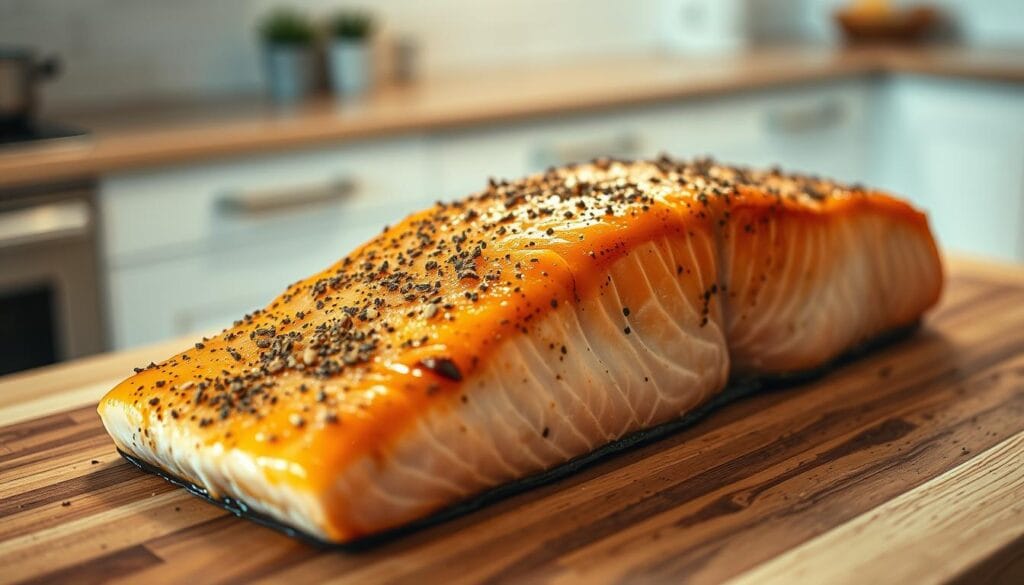
When making easy dinner ideas like teriyaki salmon, knowing the right cooking parameters is key for delicious results.
Optimal Oven Settings
For the best salmon, set your oven to 400°F. This temperature cooks the fish evenly, keeping it moist and flavorful. Adjustments might be needed for different thicknesses:
- Thin fillets (½ inch): 8-10 minutes
- Medium fillets (1 inch): 12-15 minutes
- Thick fillets (1½ inches): 15-20 minutes
Cooking Duration Guidelines
Cooking times depend on the fillet’s thickness. A general rule for oven-baked seafood is 4-6 minutes per ½ inch of salmon. Follow these guidelines to avoid overcooking:
- 6-ounce fillet at 400°F: 11-14 minutes
- Larger side of salmon (1¾ pounds): 15-18 minutes
- Frozen salmon portions: 15 minutes covered, 8-10 minutes uncovered
Testing for Doneness
Check the salmon’s internal temperature to ensure it’s perfectly cooked. The ideal range for moist, flaky fish is between 125-130°F. The FDA suggests reaching 145°F for food safety.
Pro tip: Let your salmon rest for 3 minutes after cooking to allow juices to redistribute, ensuring a tender and flavorful meal.
Remember, practice makes perfect when creating delightful easy dinner ideas with oven-baked seafood!
Glazing Methods for Maximum Flavor
Making the perfect teriyaki marinade is like an art. It turns simple fish into a flavorful dish. The glazing process is key to the salmon’s taste.
Your journey with teriyaki glaze starts with how you apply the sauce. Chefs say using different glazing methods is important for a great finish:
- Brush the salmon every 2-3 minutes during cooking
- Reduce sauce separately to create a thicker consistency
- Apply a final glaze just before serving
The secret to a great glaze is sauce reduction. Simmering your teriyaki marinade for about 5 minutes makes it more flavorful. This process caramelizes the sugars, making the glaze shiny and rich.
When glazing, use a silicone brush for even coverage. Start with a thin layer early on, then add more. The last glaze should go on in the last 1-2 minutes to avoid burning and get the most flavor.
Pro tip: For an extra flavor boost, sprinkle toasted sesame seeds over your glazed salmon just before serving.
Remember, balance is key. You want to enhance the salmon’s taste without overpowering it. A good teriyaki glaze should add to the fish’s flavor, making the dish both harmonious and tasty.
Side Dish Pairings and Serving Suggestions
Creating the perfect meal is more than just baked teriyaki salmon. The right side dishes can make your meal unforgettable. Choose dishes that complement your healthy fish to create a balanced, nutritious plate.
When planning your salmon meal, consider these pairing strategies. They boost flavor and nutrition:
Asian-Inspired Accompaniments
- Green bean gomaae with sesame dressing
- Pickled vegetable salads
- Edamame with sea salt
- Sichuan-style cucumber salad
Vegetable Side Options
Your teriyaki salmon needs vibrant vegetable friends. Roasted vegetables add depth and nutrition:
- Roasted asparagus with garlic
- Honey-glazed carrots
- Crispy air-fried broccoli
- Grilled vegetable medley
Rice and Grain Selections
Pair your salmon with these tasty grain options. They enhance your meal:
- Steamed jasmine rice
- Quinoa with sesame seeds
- Brown rice pilaf
- Egg-fried rice with vegetables
Try these pairings to make a meal that’s both delicious and healthy.
Meal Prep and Storage Solutions

Turning your baked teriyaki salmon into quick dinners is easy. This healthy dish can be made ahead of time. It makes cooking on busy weeknights a snap.
Here are some smart ways to prep your teriyaki salmon:
- Cook salmon in advance and store in airtight containers
- Prepare teriyaki sauce up to 5 days before cooking
- Pre-cut vegetables for quick assembly
Keeping your salmon fresh is important. Here’s how:
- Refrigerate cooked salmon in an airtight container
- Consume within 3 days for optimal freshness
- Freeze for up to 2 weeks if needed
To reheat, bake the salmon in a 350°F oven for 5 minutes. Pro tip: Add a splash of water to keep it moist. This way, the salmon stays tender and flavorful.
Smart meal prep can turn your teriyaki salmon into multiple delicious meals throughout the week!
Proper storage is essential for enjoying your healthy fish dishes. With these tips, you can have tasty teriyaki salmon ready in no time. It makes planning meals easy and fun.
Health Benefits and Nutritional Information
Baked teriyaki salmon is a top choice for a healthy meal. It’s packed with nutrients that boost your health and give your body what it needs.
Salmon is a great source of omega-3 fatty acids. A 3-ounce serving has:
- 22 grams of high-quality protein
- 1.5-2 grams of omega-3 fatty acids
- 155 calories
- Zero carbohydrates
- Rich in essential vitamins and minerals
Omega-3s in salmon are good for your brain and heart. They help fight inflammation and may lower heart disease risk. Women need 1.1 to 1.4 grams of omega-3s daily, and men need 1.6 grams.
Salmon is also full of vitamin B12, vitamin D, and selenium. One serving gives you over 100% of your daily vitamin B12 and 71% of vitamin D.
The Dietary Guidelines for Americans recommend eating 8 ounces of fish weekly. Baked teriyaki salmon is a great choice for a balanced diet.
Wild salmon is leaner and has more nutrients than farmed salmon. Adding this omega-3 rich meal to your diet is a tasty and healthy choice for your future health.
Common Cooking Mistakes to Avoid
Perfect salmon recipes need careful attention. Easy dinner ideas can go wrong if you ignore common mistakes. Knowing these pitfalls will make your teriyaki salmon stand out.
When cooking salmon, home cooks often face several big errors. These mistakes can ruin the dish’s quality. Knowing these can help you make your salmon consistently great.
Temperature Control Challenges
- Avoid overheating the oven, which can dry out your salmon
- Use a meat thermometer to check internal temperature
- Aim for the recommended 145°F internal temperature
Managing temperature is key in cooking easy dinners. One degree can make the difference between a juicy fillet and a tough, dry piece of fish.
Marinade Technique Mistakes
- Do not marinate salmon for more than 30 minutes with citrus-based sauces
- Avoid over-salting the fish
- Balance your marinade ingredients carefully
Marinating greatly affects the salmon’s texture and flavor. A careful approach keeps your teriyaki salmon tender and tasty.
Timing Errors to Prevent
- Cook salmon for approximately 8 minutes per inch of thickness
- Watch for opaque coloration as a doneness indicator
- Rest the fish briefly after cooking to retain moisture
Precision is the key to transforming simple salmon recipes into memorable meals.
Avoiding these mistakes will help you make restaurant-quality teriyaki salmon. It will impress your family and guests.
Conclusion
Learning to make baked teriyaki salmon can turn a simple meal into a special treat. It’s packed with omega-3s and tastes amazing. This dish shows that eating healthy can also be tasty.
Teriyaki salmon is not just good for you. It’s a way to dive into Japanese cooking while keeping your diet balanced. The secret is to keep practicing, learn about ingredients, and be ready to try new things. Every time you make it, you’ll find new ways to make it even better.
Cooking is all about patience and passion. By using the tips from this guide, you can make baked teriyaki salmon your own. Your kitchen becomes a place where you can create dishes that please everyone. Soon, your dinners will be unforgettable.
Your cooking journey is just starting. Keep exploring, tasting, and improving. Each time you try, you get closer to making the perfect teriyaki salmon. It will wow your family and friends.



